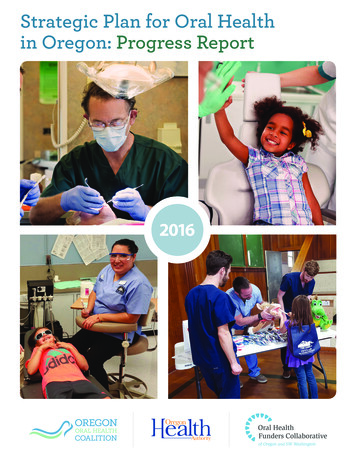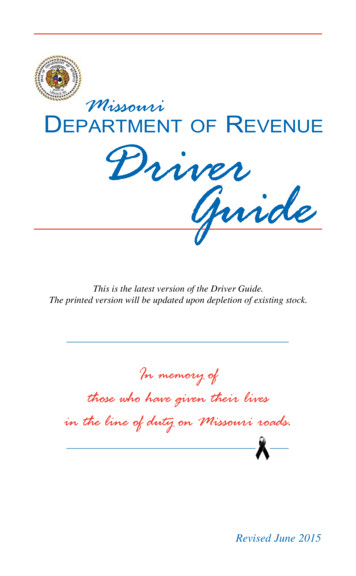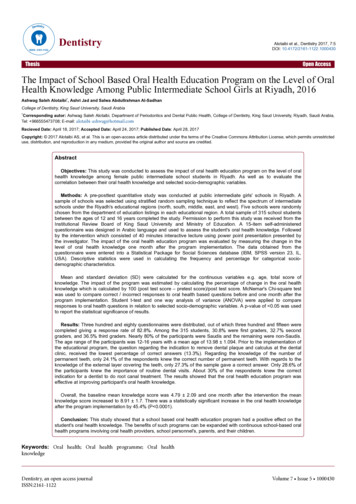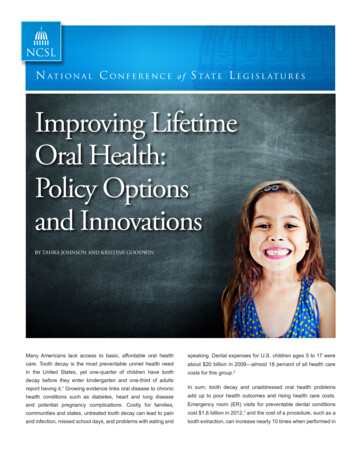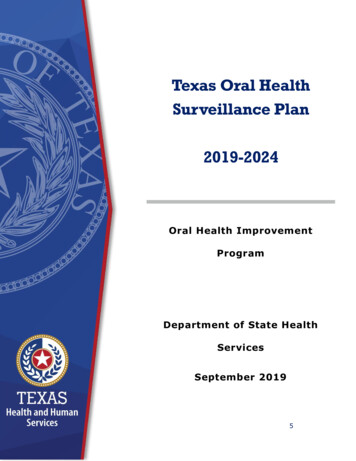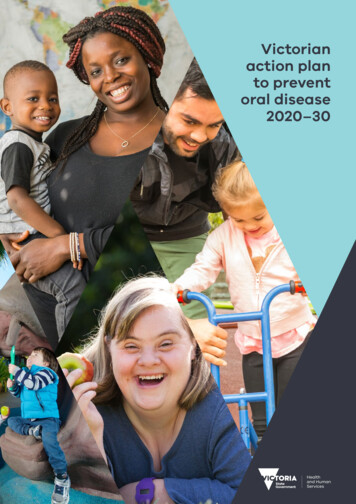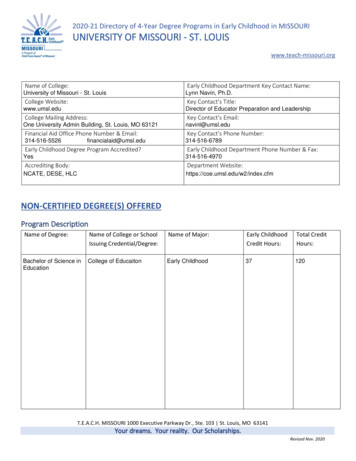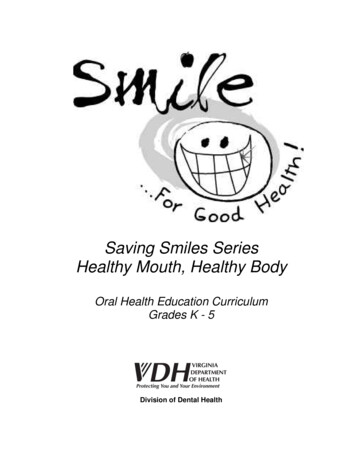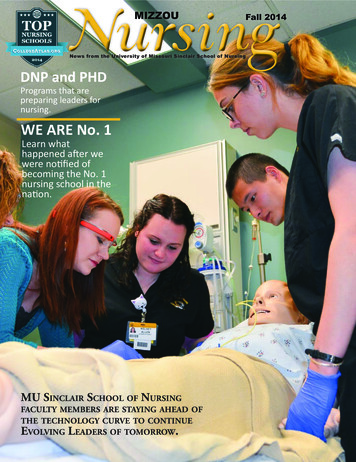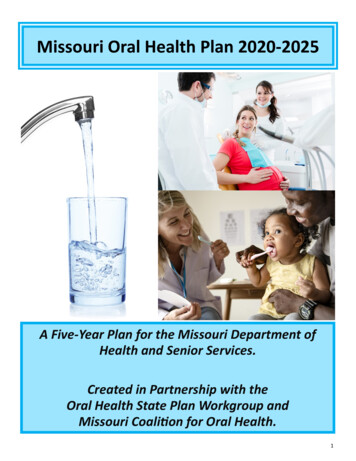
Transcription
Missouri Oral Health Plan 2020-2025A Five-Year Plan for the Missouri Department ofHealth and Senior Services.Created in Partnership with theOral Health State Plan Workgroup andMissouri Coalition for Oral Health.1
Introduction and Plan Overview for the Office of Dental HealthThe Missouri Department of Health and Senior Services (DHSS) sought the assistance of amultidisciplinary Oral Health State Plan Task Force in order to create a new five-year planfor the years 2020 through 2025. Task Force members were selected due to their expertiseand insight necessary to create a focused, yet flexible plan. The multidisciplinary task forceincluded dentists, dental hygienists, dental insurers, charitable foundations and both ofMissouri’s schools of dentistry. In addition to participating in the Task Force, the MissouriDental Association and Missouri Primary Care Association have collaborated with DHSS onoral health projects for many years, and their contributions are noted specifically withinState Plan objective and action steps.The Missouri Foundation for Health and the Missouri Coalition for Oral Health providedadditional assistance that supported the three task force meetings that were held in 2019.For more information about the Missouri Coalition for Oral Health, see page 18.During each task force meeting, DHSS provided current statistics on Missouri’s oral healthstatus. Those findings, reported in Missouri’s first comprehensive oral health burden report(www.health.mo.gov/MOHSS) provided necessary context and urgency for the state plancoals, objectives and action steps.The result of this collaboration is the Missouri Oral Health Plan 2020-2025. The plan isintended as an update to the previous five-year plan. In contrast to the previous plan thathad a broader focus, the plan presented here is intended to primarily guide efforts of DHSS.The resulting document is specific to the public health arena, expertise and areas ofresponsibility.Due to this focus, it was natural to use the three public health functions (assessment, policydevelopment and assurance) as the basis for the Plan. The Ten Essential Public HealthServices that correspond to the three public health functions have been adapted for oralhealth programs by the Association for State and Territorial Dental Directors and otherprofessional organizations, the Ten Essential Public Health Services for oral health programswere used as the foundation for the goals and activities included in the Plan.Additionally, five guiding principles set the tone for the Missouri Oral Health Plan. Theseguiding principles include responsibility, collaboration, inclusiveness, flexibility andaccountability.2
Oral Health Plan Workgroup MembersThe Missouri Department of Health and Senior Services sincerely thanks the members of the State OralHealth Plan Workgroup.Jessica BaxDirectorDHSS Division of Senior and Disability ServicesBobbi Jo GarberManaged Care DirectorDSS MO HealthNet DivisionMeagan Berry, RDHBoard MemberMissouri Coalition for Oral HealthLaura Hagood, MBAWater Fluoridation/Dental Sealant CoordinatorDHSS Office of Dental HealthDoris BoeckmanCo-Owner and Principal PartnerCommunity Asset Builders, LLCGary Harbison, MAExecutive DirectorMissouri Coalition for Oral HealthJulie Boeckman, BSProgram ManagerDHSS Office of Dental HealthAshley Herrman, MPH, CHESCommunity Outreach and Project Development DirectorMissouri Coalition for Oral HealthDiann Bomkamp, RDH, BSDHPast PresidentMDHA/ADHAAnn Hoffman, RDH, BSDHOral Health Program ConsultantDHSS Office of Dental HealthAaron Bumann, DDSPublic Policy AdvocateMissouri Academy of Pediatric DentistryValerie HuhnDirectorDMH Division of Developmental DisabilitiesScott ClardyLegislative Committee ChairMissouri Association of Local Public Health AgenciesMelissa Kleffner-Wansing, MSWGrants and Performance Management DirectorMissouri Coalition for Oral HealthJohn Dane, DDS, FAAHD, DABSCDState Dental DirectorDHSS Office of Dental HealthTeresa LeathermanDirectorDHSS Office of Rural Health and Primary CareKaren Dent, CDADirector, Oral Health Network of MissouriMissouri Primary Care AssociationRebecca LoganPolicy, Contracts and Compliance ManagerDSS MO HealthNet Managed CareMichael FrenchCo-Director, AHEC ProgramA. T. Still UniversityBridget McCandless, MDPresident/DEOHealth Forward FoundationAngela Fuller, RDH, BAPresidentMissouri Dental Hygienists’ AssociationMichael McCunniff, DDS, MSAssociate ProfessorUMKC School of Dentistry3
Molly McGrathMindy UlstadAging Program Specialist IIAging Program Specialist IIDHSS Division of Senior and Disability ServicesDHSS Division of Senior and Disability ServicesNatascha MedleyMelissa Van DyneProgram Development SpecialistExecutive DirectorDSS MO HealthNet Managed CareMissouri Rural Health AssociationAbiye Okah, MDVicki WilbersStaff PediatricianExecutive DirectorChildren’s Mercy Kansas CityMissouri Dental AssociationAndrew Shaughnessy, MARandall W. Williams, MD, FACOGHealth Policy OfficerDirectorMissouri Foundation for HealthMissouri Department of Health and Senior ServicesShantel SmithWendy WitcigLegislative DirectorDeputy Director, Community OperationsMissouri Dental AssociationDMH Division of Developmental DisabilitiesNathan Suter, DDSPrivate Practice Dentist and Owner, Green Leaf Dental CareConsultant and Owner, Access TeledentistryConsultant, Office of Dental HealthBoard Chair, Missouri Coalition for Oral HealthMissouri Department of Health and Senior Services, Office of Dental Health StaffJohn Dane, DDS, FAAHD, DABSCD, State Dental DirectorJulie Boeckman, BS, Program ManagerKally Kline, BA, Health Program Representative IIIGwen Sullentrup, BA, Health Program Representative IIIDione Snitker, Administrative AssistantMahlet Gemechu, BA, MPH, Research Analyst IISusan Connell, Project SpecialistJeffrey Bellamy, BS, RDH, Oral Health Program ConsultantBeth Cameron, M.ED., RDH, Oral Health Program ConsultantAudrey Hendee, BS, RDH, Oral Health Program ConsultantAnn Hoffman, BSDH, RDH, Oral Health Program ConsultantMolly McBride-Mooty, RDH, Oral Health Program Consultant4
Goal 1: Support and enhance access to preventive oral health services andappropriate emergency dental care.Activity 1. Promote efficient access to quality oral health care by enhancing the capacity ofthe oral health system.Action Steps: Encourage knowledge sharing and collaboration amongst medical and oral health providers forimproved oral health status. Promote the use of case management, community health workers and other methods that assistpatients to successfully complete and maintain dental treatment. Support initiatives to discourage the use of hospital emergency departments for non-traumatic dentalcomplaints. Support adult dental benefits under MO HealthNet and encourage expansion of coverage for dentures,partials and other prosthetics for adults as can be done reasonably by MO HealthNet.Activity 2. Provide Missourians with information on how to access dental services.Action Steps: Provide a list of community resources that address oral health needs in each Missouri county via theDepartment website, including but not limited to Federally Qualified Health Centers, local public healthagencies and charitable organizations. Provide information on transportation solutions throughout Missouri and work collaboratively withother organizations and MO HealthNet to strengthen transportation resources. Provide Information on MO HealthNet eligibility, covered services and special programs like thePartnership for Hope Waiver provided by the Missouri Department of Mental Health Division ofDevelopmental Disabilities.Activity 3. Support efforts to improve access to dental care.Action Steps: Promote and support the ability of Federally Qualified Health Center dental clinics to service low-incomepopulations, Medicaid recipients and individuals without dental coverage via ongoing collaboration withthe Missouri Primary Care Association. Promote safety net clinics and charitable events like the Missouri Mission of Mercy. Promote the utilization of teledentistry services across Missouri.5
Goal 2: Provide up-to-date, evidence-based oral health informationand best practices to medical and oral health professionals.Activity 1. Ensure that professionals in the medical setting (including but not limited tophysicians, nurses, physician assistants) receive up-to-date information on oral healthtopics.Action Steps: Provide up-to-date information to medical professionals about the impact of oral health on overallhealth and well-being via Department-produced publications or links to evidence-based resources. At the direction of the Office of Dental Health, provide consistent, evidence-based oral healtheducation to physicians (particularly pediatricians) and medical office staff about applying fluoridevarnish to prevent tooth decay in children in their practices. Provide school nurses with information and resources to address oral health needs among students. Provide oral health education materials to alternative medical sites such as urgent care and grocerystore/pharmacy minute clinics. Educate and promote the use of teledentistry services to medical professionals.Activity 2. Ensure oral health care providers receive up-to-date information on oral healthtopics.Action Steps: Educate oral health professionals about the link between oral health and overall health, includingHPV vaccination. Provide oral health professionals with information on evidence-based practices to prevent oral diseaseacross the lifespan. Provide oral health professionals with up-to date information on infection control and pathogenprevention in dental settings. Disseminate information to oral health practitioners on opioid prescribing practices, diversion andabuse.Activity 3. Ensure public health practitioners receive up-to-date information on oral healthtopics.Action Steps: At the direction of the Office of Dental Health, disseminate information to public health practitionerson oral health topics such as community water fluoridation, the burden of oral disease in Missouri,the importance of maternal oral health, the long-term consequences of poor oral health and ways toprevent oral disease. Provide oral health education materials to community health workers for utilization in community-basedsettings. Educate and promote the use of teledentistry services to public health practitioners.6
Activity 4. Provide long-term care facility administrators and staff with up-to-dateinformation about oral health.Action Steps: Survey older adults to determine oral health status of Missouri. Disseminate information to long-term care facilities about the importance of oral health, basic oralhygiene, how to locate dental services for residents and availability of Medicaid resources. Provide technical assistance and education on the incorporation of teledentistry into long-term carefacilities.Activity 5. Provide one centralized clearinghouse for oral health informational materials tobe housed.Action Steps: Create and manage one online database for oral health informational materials and links to materialsfrom outside resources including MO HealthNet.7
Goal 3: Support the development of the oral health workforce.Activity 1. Support and promote incentive programs that encourage oral healthprofessionals to work in rural and underserved areas.Action Steps: Cooperate with and promote the Student Loan Repayment Program and National Health ServicesCorps with the Office of Rural Health and Primary Care. Promote incentive programs for oral health students that encourage students to practice in ruraland underserved areas.Activity 2. Support the recruitment and retention of oral health professionals to work inrural and underserved areas.Action Steps: Collaborate with the Missouri Primary Care Association, Missouri School of Dentistry and Oral Health,University of Missouri-Kansas City School of Dentistry and the upcoming KCU College of Dental Medicineto recruit, place and retain students that are more likely to provide care to rural and underserved areas. Support dental schools to educate dental students on public oral health programs such as becoming aMedicaid providers and safety net clinics. Support dental school faculty lunch and learns to provide the pros and cons of public health and safetynet dental practices that can be later shared with dental students and faculty. Support and promote an increase in dental residency programs in areas of need within the state. Work with community organizations to find ways to support dentists in rural and underserved areas witheconomic challenges.Activity 3. Support programs that encourage students to pursue oral health careers.Action Steps: Collaborate with the Missouri Area Health Education Centers that sponsor pipeline programs thatencourage students from disadvantaged or minority backgrounds to pursue oral health careers. Encourage oral health professionals to participate in community-based programs to inform and assiststudents in choosing oral health as a career.Activity 4. Explore strategies to expand access to care through innovative approaches tooral health.Action Steps: Research and promote strategies such as teledentistry that seek to expand access to oral health care inunderserved areas. Promote the use of community health workers to promote quality oral health care and education topeople in underserved areas. Support initiatives that utilize oral health professionals to the full extent of their education and legalscope of practice.8
Activity 5. Assess the capacity and distribution of the oral health workforce.Action Steps: Compile and analyze data via an integrated, statewide database on the number, profession, practicecharacteristics, accepted payment sources and geographic distribution of oral health professionals inMissouri.9
Goal 4: Identify, investigate, monitor and report on oral healthproblems, determinants and disparities.Activity 1. Update and maintain the Missouri Oral Health Surveillance System.Action Steps: Update the Missouri Oral Health Surveillance system to provide the most up-to-date data possible at thelowest geographic level available. Utilize the Missouri Oral Health Surveillance system to guide implementation changes to address oralhealth disparities. Increase availability and accessibility of Missouri oral health surveillance data.Activity 2. Assess oral health status, needs, determinants and disparities.Action Steps: Acquire data on oral health status, oral health insurance coverage, determinants and other indicatorsfrom diverse data sources. Seek out detailed demographic data in order to describe disparities in oral health status by race,ethnicity, socioeconomic status, region of residence and other social determinants of oral health. Utilize oral health data to implement program and policy changes to improve the oral health status ofall Missourians. Monitor oral health status among individuals with chronic diseases, disabilities and other co-factors thatadversely affect oral health. Conduct basic screening survey of children, adults and older adults in Missouri to assess oral healthstatus.Activity 3. Assess community water fluoridation (CWF) status and needs.Action Steps: Collaborate with the Missouri Department of Natural Resources to acquire CWF data at the water systemlevel and ensure Centers for Disease Control and Prevention’s Water Fluoridation Reporting Systemreceives updated CWF data for Missouri. Collect information on CWF infrastructure and challenges in order to support communities that chooseto fluoridate their water supplies. Implement formation of a statewide fluoridation action committee.10
Activity 4. Gather, formulate and disseminate oral health-related data via publications,presentations, data requests, social media and the Missouri Oral Health SurveillanceSystem.Action Steps: Update and disseminate Oral Health Status in Missouri, such as Missouri’s Oral Health Burden Report. Utilize social media platforms for oral health information sharing. Create and disseminate special reports on oral health-related topics. Provide appropriate interpretation and context for data provided via the Oral Health Surveillance System,publication, presentations and data requests.11
Goal 5: Coordinate and participate in policy development aimed atimproving oral health in Missouri.Activity 1. Provide leadership to address oral health-related issues.Action Steps: Maintain a fully staffed Office of Dental Health and retain State Dental Director position. Actively participate in oral health-related organizations such as the Missouri Dental Association, MissouriDental Hygienists’ Association, Association of State and Territorial Dental Directors, Missouri PrimaryCare Association and other oral health organizations. Actively participate in the Missouri Coalition for Oral Health. Provide oral health representation and active participation in organizations that are dedicated toimproving Missouri Medicaid programs. Provide oral health representation and active participation on the Medicaid Transformation Programworkgroup. Disseminate best practices, models and policy changes with Local Public Health Agencies and otherinterested organizations.Activity 2. Develop plans and policies that address oral health issues.Action Steps: Update, publish and publicly disseminate the Missouri Oral Health Plan at least annually and documentprocess toward accomplishing goals. Participate in the development of MO HealthNet policies related to oral health services including the useof value-based care items. Upon the request of other state agencies, policymakers and/or stakeholders, engage and participate inplanning and policy development sessions.Activity 3. Support partnerships that address oral health needs.Action Steps: Engage and inform communities that implement oral health projects via technical assistance, letters ofsupport and data. Encourage and collaborate with partners, policymakers, organizations, professionals and otherstakeholders on oral health. Support local public health agencies participation in community partnerships related to oral health andencourage inclusion of oral health experts on local coalitions, commissions and advisory boards.12
Goal 6: Implement and collaborate with programs that focus onprevention of oral disease.Activity 1. Support school-based oral disease prevention and education programs.Action Steps: As funding allows, continue to implement the Preventive Services program, an evidence-based fluoridevarnish and oral health education program. Seek funding to promote and administer school-based dental sealant programs, particularly ineconomically disadvantaged schools. Promote school-based dental clinics to children and communities at-large. Provide oral health take-home education materials for parents of children being seen in school-basedprograms.Activity 2. Support tobacco cessation programs at DHSS as measures to prevent periodontaldisease and cancer of the oral cavity and pharynx.Action Steps: Support programs that aim to reduce tobacco and electronic cigarette use. Support initiatives that aim to limit children’s access to tobacco products (including cigarettes, smokelesstobacco and electronic cigarettes). Encourage oral health providers to include tobacco cessation in their practice.Activity 3. Collaborate with programs that outreach to low-income children and theirmothers in order to get oral health educational materials, supplies and resources tomothers and children in need.Action Steps: As funding allows, collaborate with Women, Infants and Children, and the Home Visiting Programs withinDHSS to provide oral health education and resources to high-risk mothers and children using materialsdeveloped in conjunction with the Missouri Dental Association and other organizations. Outreach to families of young children about oral health via collaborations with Head Start, Title IPreschools and similar educational settings. Outreach to physicians and women about the importance of good maternal oral health care for thehealth of mothers and infants. Participate with the Missouri Primary Care Association to encourage oral health be addressed inFederally Qualified Health Centers, particularly among pregnant women and children. Collaborate with Bureau of Immunizations within DHSS to educate and disseminate HPV educationmaterials and encourage vaccinations to oral health providers. Outreach to senior population via Area Agencies on Aging to educate on the importance of oral health. Seek funding for home visiting programs to provide information on fluoride varnish applications, otheroral health education materials and oral health supplies for families as funding allows.13
Activity 4. Promote and support community water fluoridation.Action Steps: Provide technical support and education to communities that adjust fluoride to maintain or initiate theoptimal fluoridation of their water systems. Coordinate among partners to provide educational and technical assistance to address questions aboutcommunity water fluoridation. Provide education and information on community water fluoridation to improve community perceptions. Develop and disseminate a statewide water fluoridation action plan. Provide education to elected officials and communities regarding the safety and effectiveness ofcommunity water fluoridation for the prevention of tooth decay.14
Goal 7: Increase awareness to reduce oral health disparitiesacross the lifespan.Activity 1. Educate Missourians about oral health.Action Steps: Educate the public about the keys to good oral health including proper brushing and flossing techniquesusing culturally and linguistically appropriate literature and messages via outreach, social media and theDHSS website. Educate children about oral health in school, and community based oral health programs and events.Activity 2. Increase awareness among the general public about the long-term consequencesof poor oral health.Action Steps: Educate the public about the impact of oral health status on overall health especially among expectantmothers and young children, individuals with chronic disease and other high-risk groups. Educate and promote the adoption of healthy eating habits and good nutritional practices including butnot limited to reduced sugar sweetened beverages and acidic food/drink consumption.Activity 3. Ensure educational materials and outreach strategies are culturally,educationally and linguistically appropriate for target populations.Action Steps: Create educational materials that will communicate most effectively to the population selected for eachoral health message, taking culture, gender, age and reading level into consideration. Seek funding for the translation and printing of educational materials into Spanish and other languagesneeded to target messages optimally. Collaborate with community organizations that have conducted successful outreach to populationsselected for education or initiatives, such as faith-based organizations and local partnerships. Study and inform community organizations about oral health racial and minority disparities in the Stateof Missouri.Activity 4. Train medical and oral health professionals to educate their patients on oralhealth topics.Action Steps: Educate caregivers of intellectually and developmentally disabled individuals on proper oral hygienetechniques and the impact of oral health on overall health. Promote the usage of optimally fluoridated water by children and pregnant women.15
Activity 5. As funding allows, support and direct interventions and programs that serveindividuals with disabilities.Action Steps: Collaborate with the Elk’s Mobile Dental Unit, which provides dental care for developmentally andintellectually disabled children and adults in underserved areas of Missouri. Collaborate with the Missouri Department of Elementary and Secondary Education to provide oral healtheducation, screenings and supplies for students at State Schools for the Severely Disabled. As funding allows, support programs that provide specialized training for dental professionals thatprovide care to individuals with special health care needs. Seek funding to partner with the Missouri Department of Mental Health and other organizations toaddress oral healthcare needs among individuals with developmental and intellectual disabilities.Activity 6. Support programs that serve older adults in the community and individuals inlong-term care facilities.Action Steps: Collaborate with programs within DHSS and community groups that serve older adults and individuals inlong-term care facilities to address oral health issues. Provide education to patients, caregivers and long-term care facility staff on the importance of oralhealth and proper oral hygiene for those with and without natural teeth. Provide technical assistance to long-term care facilities looking to engage in teledentistry practices forlong-term care residents. Seek support for the utilization of silver diamine fluoride for individuals in long-term care facilties.16
Goal 8: Implement, evaluate and report on the Missouri Oral HealthPlan 2020-2025.Activity 1. Ensure the Missouri Oral health Plan is followed, updated and adapted whereneeded.Action Steps: Use goals and objectives from State Oral Health Plan as a reference point for oral health initiativesimplemented by the Office of Dental Health. Promote the goals and objectives from State Oral Health Plan when discussing initiative and projectsundertaken by partners. Refer to State Oral Health Plan to develop new projects, address challenges and respond to newopportunities. Routinely report successes and progress on the State Oral Health Plan to stakeholders and staff. Gather stakeholder feedback on the Missouri Oral Health Plan effectiveness and primary plan objectivesat least annually. Update the Missouri Oral Health Plan as needed based on guidance from stakeholders and otherpartners. Plan revision and report outcomes for revising state plan in 2025. Create and disseminate progress report and possible visual dashboard to public, Oral Health State PlanTaskforce members and other stakeholders.Activity 2. Actively seek opportunities to implement goals outlined in Missouri Oral HealthPlan.Action Steps: Seek out new funding sources and collaborative partnerships that will allow DHSS to achieve goals statedin the Missouri Oral Health Plan. Encourage partners and communities that are implementing projects that align with Missouri Oral HealthPlan goals.17
About the Missouri Coalition for Oral HealthThe Missouri Coalition for Oral Health, a private non-profit 501 (c)(3) advocacy agency, is dedicated toimproving Missouri’s oral health, including the uninsured, the underserved and those with limited access tohealth care. The Coalition works to address the significant oral health challenges faced by much of thestate’s population in the varied and diverse communities of rural, urban and suburban areas of the state.The Coalition is concerned with the oral health of children, adults and the elderly; the oral health of peopleof all races and ethnicities; and the oral health of people with special health care needs and disabilities. TheCoalition works to increase health equity.The Coalition is funded by donations, memberships and grants from the Health Forward Foundation and theDentaQuest partnership. The Coalition is a member of the American Network of Oral Health Coalitions, TheAssociation of State and Territorial Dental Directors, the American Association of Public Health Dentistry andthe Oral Health Process and Equity Network. Coalition members include organizations and oral healthadvocates and professionals throughout Missouri. The resources, perspectives and skills of members areused to move Coalition goals forward while increasing the salience of oral health policy issues.The Coalition is the only organization in Missouri that is exclusively dedicated to addressing oral health policyissues. The Coalition's policy agenda is formed through a consensus process to ensure the support of abroad-based constituency that includes representation of diverse perspectives on oral health policy. Thisconsensus process allows the Coalition to be poised to convene stakeholders in the undertaking of revisingthe State Oral Health Plan. The Coalition utilized diverse stakeholders from all facets of Missouri’s oralhealth network to come together and update this plan with guidance from the Office of Dental Health.Workgroup members were selected due to their expertise and insight necessary to create a focused, yetflexible plan. The multidisciplinary workgroup included dentists, dental hygienists, dental insurers,charitable foundations and both of Missouri's schools of dentistry.During each task force meeting, the Office of Dental Health provided current statistics on Missouri’s oralhealth status. Those findings provided necessary context and urgency for the state plan goals, objectivesand action steps. The result of this collaboration is the Missouri Oral Health Plan 2020-2025. The resultingplan is specific to the public health arena, expertise and areas of responsibility. Due to this focus, it wasnatural to use the three public health functions (assessment, policy development and assurance) as the basisfor the Plan. The Ten Essential Public Health Services for oral health programs were used as the foundationfor the goals and activities included in the Plan.18
Missouri Oral Health Plan 2020-2025 A Five-Year Plan for the Missouri Department of Health and Senior Services. . Missouri School of Dentistry and Oral Health, University of Missouri-Kansas ity School of Dentistry and the upcoming K U ollege of Dental Medicine to recruit, place and retain students that are more likely to provide care to rural .
